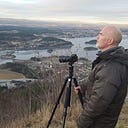Rules in Photography
Disclaimer: The images in this article are just images — they are not meant to illustrate anything.
I very often have this strong negative reaction when a newsletter arrives in my inbox or I see an online article where the heading for instance reads: “5 rules to follow when composing an image” — or something to that effect.
I would have been far more positive if the heading read: “10 approaches to consider when composing a landscape image”.
I have plenty of personal preferences when it comes to photography. However, I try to avoid making rules or laws based on what I prefer.
In my thinking photography is a creative way of expressing how we see things, or a way of mirroring our personality with its likes and dislikes. And none of that can be contained within the boundaries of various rules. I honestly don’t think it is healthy to legislate taste or create a framework on how things ought to look.
When I am out shooting I solely work on intuition based on what my eyes see through the viewfinder, and how what I see impacts me. Do I get a sense of harmony and balance, or does what I see create a sort of disharmony in me? I notice I have a tendency to gravitate towards the golden rule or divide things into thirds to attain harmony, but far from always.
I also notice that I prefer simple compositions and often try to avoid complexity or compositions with too many disturbances. Sometimes I like lines — at other times lines do not work at all. Quite often I like to have strong foreground elements that work as anchors, balance things or add visual interest to a scene. However, that is not either a rule I follow simply because it may not be possible to find a foreground that works, or that I omit it completely for other reasons.
Admittedly, I have deleted thousands of raw files which for various reasons didn’t look as appealing on the computer screen as they did in the field. At other times the opposite is true. And sometimes I know I have images on my memory card that will be deleted, but I shoot them anyway just for the fun of it.
When all this is mentioned I have no problems admitting that “rules” can be of help in the beginning guiding people towards a sort of structure while they work towards carving out their own unique style in expressing themselves.
For my own part I cannot draw conclusions or make rules based upon the complex interactions between eyes, brain and emotions — quite often I find it difficult to articulate why something works in my eyes or why something doesn’t work. I can only to a certain degree articulate what I notice about my own reactions and preferences. It may for example be that I find the blue tones in the sky way too saturated, but this aspect of the image may work super well in the artist’s eyes and many of those who behold the image.
Taste or preferences isn’t a static quantity. Perhaps we see this most clearly when we analyze our own work. What worked five years ago we now may find wanting in so many ways. It is not unlikely that we will detect a gradual development towards something more refined. In other words, we have abandoned those ‘rules’ which once dictated the final look of our images.
I am, for instance, very fond of light and colors in a landscape image. When I started out with photography I quite often overdid those elements in my editing. These days I am less prone to exaggerate colors and light, but of course it still happens. However, many found those images I now find wanting beautiful.
I tremendously value the freedom to express myself in my work. If someone one day told me that I no longer can add my personal twist to my images I would wither, and the appeal and fun of photography would be lost forever.
“Learn the rules like a pro, so you can break them like an artist.” (Pablo Picasso)
